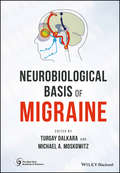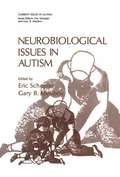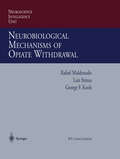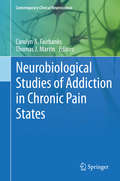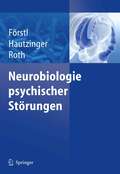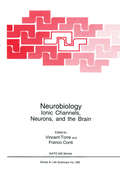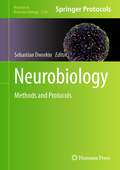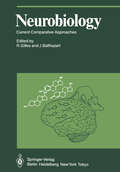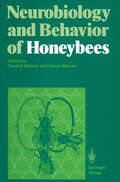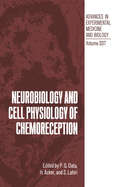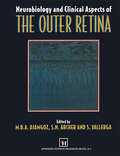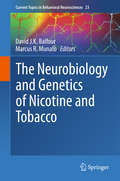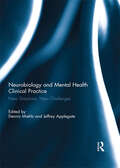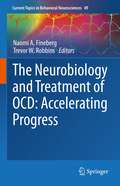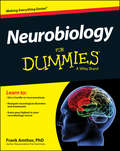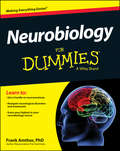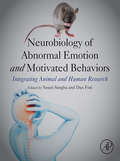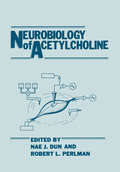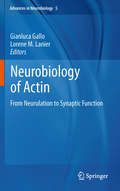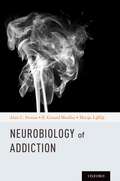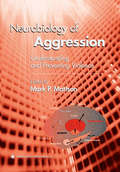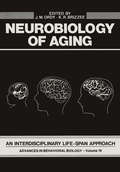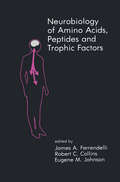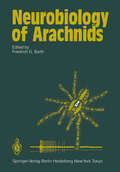- Table View
- List View
Neurobiological Basis of Migraine (New York Academy of Sciences)
by Turgay Dalkara Michael A. MoskowitzPublished with the New York Academy of Sciences A timely, broad-ranging exploration of the neurobiological basis and molecular mechanisms of migraines Migraines impact the lives of a significant portion of the world's population, afflicting sufferers with severe pain, nausea, and often visual impairment. The WHO views migraines as an important public health issue, and ranks them in its top twenty most disabling illnesses. Neurobiological Basis of Migraine reviews the latest advances made in our understanding of the primary basic mechanisms of migraine headache and provides valuable insights into how these findings are being translated into novel treatment and prevention strategies around the world. Written for researchers and clinicians alike, the book features edited contributions from distinguished experts in the field, taking a focused, yet wide-ranging approach to the subject. It begins by exploring the pathways and networks mediating migraine headaches, their underlying physiological mechanisms, characteristics of visceral pain, and the concept of dural neurogenic inflammation. From there the authors delve into the mechanisms sustaining the head pain and photophobia associated with migraines, and they review the pharmacology of newly discovered migraine treatments. These basic chapters are followed by clinical and genetic studies linking to key issues, including cortical spreading depression, ion channels, transporters, and epilepsy. Reviews of the latest advances in our understanding of the neurobiological basis of migraine Translates important research findings from around the globe into novel treatments strategies currently being investigated Provides researchers and clinicians with a deep understanding of the primary mechanisms of migraine from migraine modeling to clinical applications Includes contributions by many of the most respected researchers in the field, world-wide Discusses exciting recent developments in migraine mutations and their role in CSD, as well as the role of CSD in aura and trigeminal activation Timely, comprehensive, and authoritative, Neurobiological Basis of Migraine is an indispensable working resource for clinicians and migraine, headache, and pain researchers, including neurobiologists, neuropharmacologists, neurologists, and vascular neurobiologists, as well as graduate students in those fields who are involved in researching migraine headaches.
Neurobiological Issues in Autism (Current Issues in Autism)
by Eric Schopler Gary B. MesibovAs a division of the School of Medicine at the University of North Carolina at ChapeI Hili, TEACCH has always been involved in the latest biological research on autism and related developmental disabilities. However, until now there has not been sufficient information to justify aseparate volume on this most important topic. Recent advances both in our under standing of the brain and in the technology to facilitate the measurement of neurological functioning have stimulated significant growth, which is reflected in this volume. As with the preceding books in this series, Current Issues in Autism, this volume is based on one of the annual TEACCH conferences held in ChapeI Hili each May. The books are not simply published proceedings of the conference papers, however. lnstead, conference participants are asked to develop chapters around their presentations, and other international experts whose work is beyond the scope of the conference, but related to the major theme, are asked to contribute as weil. These volumes are intended to provide the most current knowledge and professional practice available to us concerning major issues in autism.
Neurobiological Mechanisms of Opiate Withdrawal (Neuroscience Intelligence Unit)
by Rafael Maldonado Luis Stinus George F. KoobSome general aspects of opiate dependence are described in a first section including a brief historical description and an explanation of the different models currently used to investigate opiate dependence. The neurobiological bases of opiate withdrawal are detailed in a second section, which particularly emphasizes the neurophysiological adaptative changes, the processes of homologous and heterologous regulation, and the role played by different brain structures and several endogenous peptides acting as antiopiates. The last part reports several basic aspects more directly related to the clinical perspectives of opiate dependence, such as the new expectations in the treatment of opiate withdrawal or the relationships between sensitization, tolerance and withdrawal.
Neurobiological Studies of Addiction in Chronic Pain States (Contemporary Clinical Neuroscience #17)
by Carolyn A. Fairbanks Thomas J. MartinUsing rodent models, this volume explores the basic neurobiology of the relationship among chronic pain, opioid pharmacology, and addiction.
Neurobiologie psychischer Störungen
by Hans Förstl Martin Hautzinger Gerhard RothInnerhalb der letzten Jahrzehnte ist das Wissen um die neurobiologischen Grundlagen geradezu explodiert. Für die „Neurobiologie" haben interdisziplinäre Autorenteams jede Störung sowohl von psychiatrisch-neurowissenschaftlicher als auch von der psychologischen Seite genau unter die Lupe genommen. Nur wer die Grundlagen versteht kann die Störungen einordnen Vermittelt dem Leser das neurobiologische Wissen sämtlicher Störungen von A wie „Affektive Störung" bis Z wie „Zwangsstörung" Hervorragende Einführung und DAS Referenzwerk für alle Aspekte der modernen Psychiatrie
Neurobiology: Ionic Channels, Neurons and the Brain (Nato Science Series A: #289)
by Franco Conti Vincent TorreUnderstanding how the brain works is undoubtedly the greatest challenge for human intelligence and one of the most ambitious goals of contemporary science. We are certainly far from this goal, but significant advancements in several fields of Neuroscience and Neurobiology are being obtained at an increasing pace. The NATO ASI School in Neurobiology, held in Erice May 2-12,1995, as the 23rd Course of the International School of Biophysics, provided an update on three basic topics: Biophysics and Molecular Biology ofIon Channels, Sensory Transduction, and Higher Order Functions. Current knowledge on these subjects was covered by formal lectures and critical discussions between lecturers and participants. This book collects original contributions from those scientists who attended the School. Many students presented their results in poster sessions, steering lively informal discussions. A selection of these contributions is also included. A major portion of the program of the School was devoted to a general overview of current trends of thought and experimental approaches in neurobiology, emphasising the importance of understanding molecular aspects of the elementary events underlying sensory transduction and processing in the nervous system, without indulging however in a pure reductionistic view of such complex phenomena. Recent studies of molecular biology and the electrophysiology of heterologously expressed ionic channels, have shed new light on the molecular mechanisms underlying ionic permeation of excitable membranes and its regulation by physical and chemical parameters.
Neurobiology: Methods and Protocols (Methods in Molecular Biology #2746)
by Sebastian DworkinThis volume will serve as a guide for students in the field of neurobiology, and be a bridge between basic science researchers, doctors, and surgeons in clinical practice. Written in the highly successful Methods in Molecular Biology series format, chapters include introductions to their respective topics, lists of the necessary materials and reagents, step-by-step, readily reproducible laboratory protocols, and tips on troubleshooting and avoiding known pitfalls.Authoritative and cutting-edge, Neurobiology: Methods and Protocols aims to ensure successful results in the further study of this vital field.
Neurobiology: Current Comparative Approaches (Proceedings in Life Sciences)
by R. Gilles J. BalthazartThis volume is one of those published from the proceedings of the invited lectures to the First International Congress of Comparative Physiology and Biochemistry I organized at Liege (Belgium) in August 1984 under the auspices of the Section of Comparative Physiology and Biochemistry of the International Union of Biological Sciences. In a general foreword to these different volumes, it seems to me appropriate to consider briefly what may be the comparative approach. Living organisms, beyond the diversity of their morphological forms, have evolved a widespread range of basic solutions to cope with the different problems, both organismal and environmental with which they are faced. Soon after the turn of the century, some biologists realized that these solutions can be best comprehended in the frame work of a comparative approach integrating results of physiological and biochemical studies done at the organismic, cellular and molecular levels. The development of this approach amongst both physiologists and biochemists remained, however, extremely slow until recently.
Neurobiology and Behavior of Honeybees
by Randolf Menzel Alison MercerAt the beginning of the century, Karl von Frisch inaugurated the experimental analysis of bee behavior with his studies on form and color vision. Since then, experimental analysis of bee behavior has been extended to their orientation in space and time, sensory capabilities, and communication within a social group. How does a creature with a brain volume of scarcely one cubic millimeter generate such varied and complex behavior? This volume represents the latest research on the behavior and neurobiology of bees. Topics include: dance communication, foraging and search behavior, decision making, color vision, learning and memory, structure and function of brain neurons, immunocytological characterization of neuropils and identified neurons,and neuropharmacological studies of stereotyped and learned behavior. Together these papers illustrate the challenge that bee behavior presents to the neuroethologist as well as the progress that this field has made in recent years in the tradition of von Frisch's pioneering work.
Neurobiology and Cell Physiology of Chemoreception (Advances in Experimental Medicine and Biology #337)
by P. G. Data H. Acker Sukhamay LahiriThis volume records the papers presented in Chieti, Italy, at the 1991 meeting of the International Society for Arterial Chemoreception (ISAC). This was the eleventh of a series of assemblies held since 1959. This field of research, which examines the critical function and mechanisms of O and pHIPC0 sensitive cells in 2 2 the body, is unique in that it encompasses diverse biological and medical areas. The reader of this book will note chapters concerning modem techniques like in situ hybridization; analysis of cell membrane channels and intracellular ion movements; immunohistochemistry of peptides, hormones, and the corresponding receptors of chemoreceptor cells; and systemic analysis of reflex pathways involving chemoreceptor cells and their meaning in health and disease. This broad spectrum will appeal to readers interested in the chemoreceptor field, as well as young scientists seeking a scientific field where not only structural analysis but also a sense for functional connections is required. In recognition of the importance of the contribution of a new scientific generation to this field, ISAC awarded the prestigious F. de Castro-C. Heymans E. Neil prize to A. G6rlach, a young scientist. Also at this meeting, the Ferdinando Data Foundation Award, for helping scientists from non-developed countries to pursue their interest in chemoreception, was initiated. ISAC held plenary lectures in honor of C. Eyzaguirre and R. Forster, both of whom have contributed greatly to research in the chemoreceptor field.
Neurobiology and Clinical Aspects of the Outer Retina
by M.B. Djamgoz S. Archer S. VallergaThis book deals with the cellular biology, biochemistry and physiology of photoreceptors and their interactions with the second-order neurons, bipolar and horizontal cells. The focus is upon the contributions made by these neurons to vision. Thus the basic neurobiology of the outer retina is related to the visual process, and visual defects that could arise from abnormalities in this part of the retina are highlighted in the first 16 chapters. Since all vertebrate retinas have the same basic structure and physiological plan, examples are given from a variety of species, with an emphasis upon mammals, extending to human vision. The last four chapters approach the problem from the other end. This part of the book covers a range of clinical conditions involving visual abnormalities that are due to cellular defects in the outer retina. Although the contents of this book do not represent the proceedings of a conference, the concept arose at an international symposium on 'Recent Advances in Retinal Research' which was held at the International Marine Centre in Oristano, Sardinia. We hope that the book will give a coherent, up to date review of the neurobiology and clinical aspects of the outer retina and encourage further integration of these areas. Retinal neurobiology has been an intense field of investigation for several decades. More recently, it has seen significant advances with the application of modern techniques of cell and molecular biology.
The Neurobiology and Genetics of Nicotine and Tobacco (Current Topics in Behavioral Neurosciences #23)
by David J. K. Balfour Marcus R. MunafòThe primary purpose of this book and its companion volume The Neuropharmacology of Nicotine Dependence is to explore the ways in which recent studies on nicotine and its role in tobacco addiction have opened our eyes to the psychopharmacological properties of this unique and fascinating drug. While the present volume considers the molecular and genetic factors which influence behavioral responses to nicotine and how these may impact on the role of nicotine in tobacco dependence, the book The Neuropharmacology of Nicotine Dependence focuses on the complex neural and psychological mechanisms that mediate nicotine dependence in experimental animal models and their relationship to tobacco addiction in humans. These volumes will provide readers with a contemporary overview of current research on nicotine psychopharmacology and its role in tobacco dependence from leaders in this field of research and will hopefully prove valuable to those who are developing their own research programmes in this important topic.
Neurobiology and Mental Health Clinical Practice: New Directions, New Challenges
by Dennis Miehls and Jeffrey ApplegateThis book illustrates the current findings of interpersonal neurobiology that inform knowledge building and clinical practice. Contributions cover an impressive range of material including how neurobiology interfaces with clinical work with children, individuals with substance abuse issues, couples and clients with trauma histories. Leading mental health clinician-scholars describe path-breaking explorations at the neurobiological frontiers of 21st century clinical theory and practice. Representing the fields of social work, psychology and psychiatry, these authors creatively apply research findings from the ongoing revolution in social and behaviour neuroscience to a diverse array of clinical issues. Contributions include elaborations of theory (the evolving social brain; new directions in attachment, affect regulation and trauma studies); practice (neurobiologically informed work with children, adults, couples and in the conduct of supervision); and emerging neuroscientific perspectives on broader mental health issues and concerns (substance abuse; psychotropic medications; secondary traumatic stress in clinicians; the neurodynamics of racial prejudice; the dangers of forfeiting humanism to our current romance with the biological). Together, these chapters equip readers with state-of-the-art knowledge of the manner in which new understandings of the brain inform and shape today’s professional efforts to heal the troubled mind. This book was originally published as a special issue of Smith College Studies in Social Work.
Neurobiology and Mental Health Clinical Practice: New Directions, New Challenges
by Dennis Miehls Jeffrey ApplegateThis book illustrates the current findings of interpersonal neurobiology that inform knowledge building and clinical practice. Contributions cover an impressive range of material including how neurobiology interfaces with clinical work with children, individuals with substance abuse issues, couples and clients with trauma histories. Leading mental health clinician-scholars describe path-breaking explorations at the neurobiological frontiers of 21st century clinical theory and practice. Representing the fields of social work, psychology and psychiatry, these authors creatively apply research findings from the ongoing revolution in social and behaviour neuroscience to a diverse array of clinical issues. Contributions include elaborations of theory (the evolving social brain; new directions in attachment, affect regulation and trauma studies); practice (neurobiologically informed work with children, adults, couples and in the conduct of supervision); and emerging neuroscientific perspectives on broader mental health issues and concerns (substance abuse; psychotropic medications; secondary traumatic stress in clinicians; the neurodynamics of racial prejudice; the dangers of forfeiting humanism to our current romance with the biological). Together, these chapters equip readers with state-of-the-art knowledge of the manner in which new understandings of the brain inform and shape today’s professional efforts to heal the troubled mind. This book was originally published as a special issue of Smith College Studies in Social Work.
The Neurobiology and Treatment of OCD: Accelerating Progress (Current Topics in Behavioral Neurosciences #49)
by Naomi A. Fineberg Trevor W. RobbinsThe book highlights important new research approaches of clinical relevance, written by prominent researchers in the field of OCD and related disorders. A broad range of topics is covered, beginning with a description of the phenotypic features of the OCD followed by chapters on developmental aspects, animal models, genetic and biological models including neuro-inflammation, functional neuroimaging correlates and information-processing accounts. Finally, existing and novel treatment approaches are covered including clinical and pharmacogenetic treatment models. In this way the volume brings together the key disciplines involved in the neurobiological understanding of OCD to provide an update of the field and outlook to the future. Together, the volume chapters provide focused and critical reviews that span a broad range of topics suitable for both students and established investigators and clinicians interested in the present state of OCD research.
Neurobiology For Dummies
by Frank AmthorThe approachable, comprehensive guide to neurobiology Neurobiology rolls the anatomy, physiology, and pathology of the nervous system into one complex area of study. Neurobiology For Dummies breaks down the specifics of the topic in a fun, easy-to-understand manner. The book is perfect for students in a variety of scientific fields ranging from neuroscience and biology to pharmacology, health science, and more. With a complete overview of the molecular and cellular mechanisms of the nervous system, this complete resource makes short work of the ins and outs of neurobiology so you can understand the details quickly. Dive into this fascinating guide to an even more fascinating subject, which takes a step-by-step approach that naturally builds an understanding of how the nervous system ties into the very essence of human beings, and what that means for those working and studying in the field of neuroscience. The book includes a complete introduction to the subject of neurobiology. Gives you an overview of the human nervous system, along with a discussion of how it's similar to that of other animals Discusses various neurological disorders, such as strokes, Alzheimer's disease, Parkinson's disease, and schizophrenia Leads you through a point-by-point approach to describe the science of perception, including how we think, learn, and remember Neurobiology For Dummies is your key to mastering this complex topic, and will propel you to a greater understanding that can form the basis of your academic and career success.
Neurobiology For Dummies
by Frank AmthorThe approachable, comprehensive guide to neurobiology Neurobiology rolls the anatomy, physiology, and pathology of the nervous system into one complex area of study. Neurobiology For Dummies breaks down the specifics of the topic in a fun, easy-to-understand manner. The book is perfect for students in a variety of scientific fields ranging from neuroscience and biology to pharmacology, health science, and more. With a complete overview of the molecular and cellular mechanisms of the nervous system, this complete resource makes short work of the ins and outs of neurobiology so you can understand the details quickly. Dive into this fascinating guide to an even more fascinating subject, which takes a step-by-step approach that naturally builds an understanding of how the nervous system ties into the very essence of human beings, and what that means for those working and studying in the field of neuroscience. The book includes a complete introduction to the subject of neurobiology. Gives you an overview of the human nervous system, along with a discussion of how it's similar to that of other animals Discusses various neurological disorders, such as strokes, Alzheimer's disease, Parkinson's disease, and schizophrenia Leads you through a point-by-point approach to describe the science of perception, including how we think, learn, and remember Neurobiology For Dummies is your key to mastering this complex topic, and will propel you to a greater understanding that can form the basis of your academic and career success.
Neurobiology of Abnormal Emotion and Motivated Behaviors: Integrating Animal and Human Research
by Susan Sangha Dan FotiNeurobiology of Abnormal Emotion and Motivated Behaviors: Integrating Animal and Human Research pulls together world-renowned leaders from both animal and human research, providing a conceptual framework on how neuroscience can inform our understanding of emotion and motivation, while also outlining methodological commonalities between animal and human neuroscience research, with an emphasis on experimental design, physiological recording techniques and outcome measures. Typically, researchers investigating the neurobiology of emotions focus on either animal models or humans. This book brings the two disciplines together to share information and collaborate on future experimental techniques, physiological measures and clinical outcomes.Integrates animal and human research to aid readers in discovering a clear path forward for translating basic science to clinical applicationsProvides overviews of the most recent research into the neuroscience behind maladaptive behaviors and psychiatric disordersExplores the commonalities in methods and outcome measures between animal and human researchers and how those commonalities can be harnessed for future collaboration and translational work
Neurobiology of Acetylcholine
by Nae J. Dun Robert L. PerlmanThis Festschrift volume in honor of Professor Alexander Karczmar is the outcome of a three-day symposium entitled "Neurobiology of Acetylcholine" held at Loyola University Medical Center from June 3 to 5, 1985. This volume serves two purposes. It expresses the respect and admiration of the contributors to Alex Karczmar, and it provides a forum for detailing recent advances in the cholinergic field which has attracted the undivided and untiring attention of Dr. Karczmar over some 40 years. During this period, the cholinergic system has grown from its infancy to become one of the most studied and understood transmitter systems today. Dr. Karczmar's interest in cholinergic system is appropriately reflected by the range of topics, molecular, cellular, developmental, behavioral and toxicological, that were discussed here. A detailed synopsis of Dr. Karczmar's research and his contributions to the field of cholinergic systems can be found in the following chapter by his close friend and colleague, Dr. George Koelle. We would like to take this opportunity to thank the enthusiastic responses of the participants making this Festschrift a memorable event.
Neurobiology of Actin: From Neurulation to Synaptic Function (Advances in Neurobiology #5)
by Gianluca Gallo and Lorene M. M. LanierThis text is an introduction to the interface between the actin cytoskeleton and the myriad of issues fundamental to the understanding of the nervous system. It covers the neurobiology of actin ranging from basic cellular organization and function to the roles of actin in the health and disease states of the nervous system. Its opening chapter presents the fundamental concepts required to appreciate the details of the molecular machinery that regulates actin in a cellular context, setting the stage for the first part of the book which reviews the neurobiology of actin at the cellular level. The latter section of the book then discusses the functions of actin in the context of neurobiological issues ranging from early development to synaptic function and disease states of the nervous system. This text is intended for neuroscientists interested in investigating the actin cytoskeleton in the context of their particular neuroscience research program, and its chapters are cross-referenced in order to assist readers in finding relevant information that is covered in greater depth in other chapters.
Neurobiology of Addictions
Neurobiology of Addiction highlights some of the most promising research areas of the rapidly expanding field of addiction. It will be useful as a practical tool for clinicians, research investigators, and trainees-both in addiction and in other illnesses with overlapping mechanisms-as well as an informative resource for non-technical readers who are interested in addiction or mental health policy. The editors have combined their areas of expertise to provide a unique perspective into the prevention and treatment of addictive disorders. Their approach addresses addiction in the broader context of behavioral processes and survival-related adaptations, focusing on its neurobiological precursors and drawing parallels between addictions and other recurrent or progressive psychiatric disorders. The book also emphasizes resilience, clinical contexts of addictive behavior, and treatment strategies that target its underlying neurobiological mechanisms.
Neurobiology of Aggression: Understanding and Preventing Violence (Contemporary Neuroscience)
by Mark P. MattsonAggression is a highly conserved behavioral adaptation that evolved to help org- isms compete for limited resources and thereby ensure their survival. However, in modern societies where resources such as food, shelter, etc. are not limiting, aggr- sion has become a major cultural problem worldwide presumably because of its deep seeded roots in the neuronal circuits and neurochemical pathways of the human brain. In Neurobiology of Aggression: Understanding and Preventing Violence, leading experts in the fields of the neurobiology, neurochemistry, genetics, and behavioral and cultural aspects of aggression and violence provide a comprehensive collection of review articles on one of the most important cross-disciplinary issues of our time. Rather than summarize the topics covered by each author in each chapter, I present a schematic diagram to guide the reader in thinking about different aspects of aggr- sive and violent behavior from its neurobiological roots to environmental factors that can either promote or prevent aggression to visions of some of the most horrific acts of violence of our times, and then towards the development of strategies to reduce aggressive behavior and prevent violence. It is hoped that Neurobiology of Aggression: Understanding and Preventing V- lence will foster further research aimed at understanding the environmental genetic and neurochemical roots of aggression and how such information can be used to move forward towards the goal of eliminating violence.
Neurobiology of Aging: An Interdisciplinary Life-Span Approach (Advances in Behavioral Biology #16)
by J. OrdyAging is one of the most universal and inevitable social and sci entific challenges confronting man. The lives of all multicellular organisms begin with conception, extend through phases of development, maturity, senescence and finally end in death. Man is no exception, but has the unique feature of a complex brain. It plays an integra tive role in adaptation to the physical and social environments through reflexes, conditioning and more complex forms of learning. The brain is a repository for both inherited and acquired information. With the development of speech and the formation of symbolic language, the human brain has made it possible to transmit information cultur ally (horizontal) to other members of society, in addition to genetic (vertical) transmission to progeny. This horizontal transmission, which has reached its highest form in man, is a powerful extension of genetic transmission. The brain may provide man all that is of im portance in life. It has played a key role in the evolution of life by maintaining and extending the life span. Many mental or intellectual capacities of man reach a peak in early adulthood, remain relatively constant throughout maturity and then appear to decline during senescence. Behaviorally, there appears to be a decrease in sensory, learning and motor functions with aging in all mammalian species. As integrated adaptive control systems, the brain and neuroendocrines have been closely associated with the homeostatic adaptation to environmental challenges throughout .the life span.
Neurobiology of Amino Acids, Peptides and Trophic Factors (Topics in Neurosurgery #8)
by Eugene M. Johnson Robert C. Collins James A. FerrendelliThis volume represents the proceedings of the third in a series of annual inter national symposia. The first, The Neuroregulation of Autonomic, Endocrine, and Immune Systems, was held in Indianapolis in the fall of 1985. The second, Psychological and Biological Approaches to the Understanding of Human Disease, was held in Bielefeld, Germany in the fall of 1986. The theme of this series concerns the communication between the central nervous system and the other major systems of the body, and the purpose is to monitor the frontiers of research into these neuronal/hormonal regulatory interactions and their application to medicine. The present volume deals with the role of peptides and amino acids in these information transfer processes. Great strides have been made in exploring the important role of amino acids and pep tides in neuroregulation, and the ongoing biotechnology revolution promises signi ficant scientific and medical advances throughout the next decade and beyond. The work described in this volume captures the great excitement and pro mise of this biomedical renaissance. This meeting was cosponsored by Searle/ Monsanto and Washington University and held in St. Louis in the early fall of 1986. A major contributor to these proceedings was Dr. Thomas O'Donohue whose chapter deals with his work in characterizing the endogenous ligands for the PCP and sigma opioid receptors. Tom's personality and career personi fied the dedication of this series to the principle of a broad multidisciplinary approach to scientific problems.
Neurobiology of Arachnids
by K. S. Babu F. G. Barth A. D. Blest B. Claas Gerta Fleissner Günther Fleissner R. F. Foelix L. Forster P. Görner M. F. Land R. Legendre H. Mittelstaedt A. Reißland T. M. Root E. A. Seyfarth R. G. Sherman P. Weygoldt S. YamashitaArachnids rarely come to mind when one discusses arthropod neurobiology. In fact much more is now known and written about the nervous systems of insects and crustaceans. Several arguments have led us to conclude, however, that the time has come to document impor tant aspects of the neurobiology of spiders, scorpions, and their kin, as well. Studies of arachnid neurobiology have made considerable progress since the last comprehensive treatment by Bullock and Horridge in their monumental monograph on invertebrate nervous systems pub lished in 1965. This is especially true for research performed in the last decade. Several problems related to the structure and function of arachnid nervous and sensory systems have now been studied in con siderable depth but have so far not been given adequate space under one cover. A particular incentive to produce this book has been the impor tance attributed to comparative approaches in neurobiology. Neglect ing a large taxonomic group such as the arachnids - which comprises some 60,000 species living a wide range of different lives - would mean ignoring an enormous potential source of knowledge. In writing the chapters of this book we have striven to present some of the unique features of the arachnids. But the result of our efforts is not just meant to contribute to an understanding of the particularities of the arach nids.
